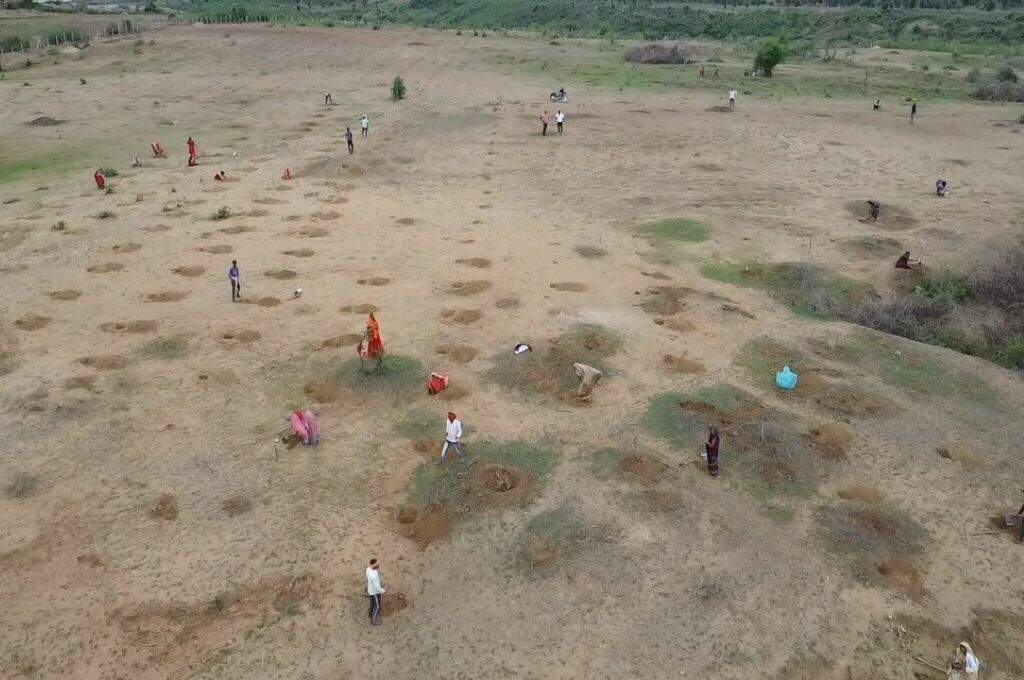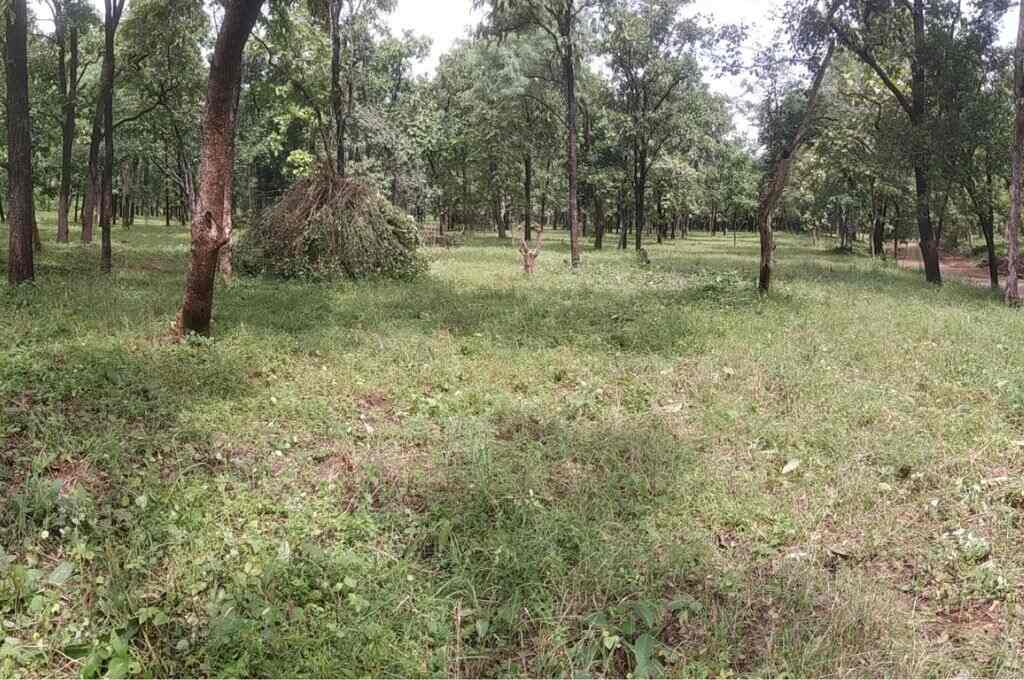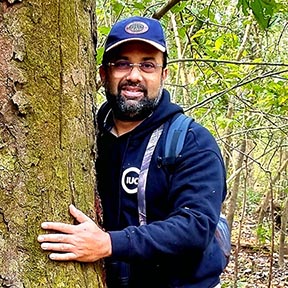A shrub with small, beautiful flowers, Lantana camara is believed to have arrived in India in the 1800s as a colonial import from Latin America. Initially brought in by the British as an ornamental plant, the highly adaptable weed soon spread across the country, taking over forests. By 2020, it was estimated to occupy more than 40 percent of the area in India’s tiger habitats.
Lantana camara severely affects the productivity of the forest ecosystem, which comprises several varieties of grasses, shrubs, and herbs. Once an invasive species like lantana takes over, it replaces the native flora of a place on which a variety of birds, insects, and animals feed. In the course of The Corbett Foundation’s (TCF) work as a nonprofit in the buffer zones of the tiger reserves of Corbett, Bandhavgarh, Kanha, Satpuda, and Kaziranga, we have seen the infestation of lantana threaten the long-term functionality of these forest ecosystems. When the ecological balance is disturbed in this way, it may have several repercussions, including an increase in pests that adversely impact agriculture. There are other concerns, too. In areas in and around tiger reserves, dense lantana thickets provide an ideal hiding place for tigers, leopards, and sloth bears. Since people living near these areas frequently visit the forest to collect non-timber forest products (NTFPs), firewood, and fodder for their sustenance and livelihood, they are prone to animal attacks.
Considering the large-scale impact of lantana in forest areas, in 2017, TCF decided to start a year-long pilot project in a buffer region near Bandhavgarh National Park in Madhya Pradesh. We partnered with the state forest department for this project. It involved fencing off five hectares of forest land and weeding it. After witnessing positive results on that small plot, we scaled our habitat restoration programme to larger forest areas in Madhya Pradesh and to other states such as Gujarat and Uttarakhand.
The importance of habitat restoration
Habitat restoration involves removing invasive species and planting trees with gaps between them to allow the regeneration of local flora. While doing this, we must make sure to only plant flora that is native to that region. We should avoid introducing any new plant species, even if non-invasive, so as not to disturb the ecological balance of the area. In regions such as Kachchh in Gujarat, which is primarily a grassland habitat in a semi-arid landscape, another exotic invasive species Prosopis juliflora has proliferated, destroying large swathes of this unique ecosystem.
Weeding a forest is a difficult process that demands persistence.
It is against the principles of habitat restoration to tinker with the natural environment of a place; this is what sets it apart from blanket plantation. Those working on reforestation should let these regions remain as they are. It is also much more effective when compared to expensive and ad hoc plantation drives we have seen in the country over decades that have failed to increase India’s green cover.
However, weeding a forest is a difficult process that demands persistence. Lantana has to be removed from a patch of land for at least two to three years continuously. During this period, that land is fenced off and no grazing is allowed in the area. We also dig pits for planting the saplings of native plants, and sometimes even create water bodies so that we can harvest rainwater to replenish the groundwater table and to attract birds and other fauna.
In the first year, it is massive work because we are clearing fully grown thickets. In the second and third year, too, we have to remove some amount of the lantana that will regrow because it is a hardy species. From then on, its growth decreases and the weeding process requires lesser labour input.

Involving the people who matter
Community members from nearby villages are employed to work on the weed removal and reforestation, and are paid according to the rates prescribed by the forest department. We have also started self-help groups with the villagers in places like Kanha Tiger Reserve. These groups are now engaged in growing the saplings of native trees that we have linked to the Government of India’s Aajeevika Yojana, and these saplings will eventually be purchased by either TCF or other government departments for plantation. Some of the villagers are also employed as security guards at the site to prevent vandalism, trespassing, or livestock grazing.
As a nonprofit, we become the bridge between the villagers and the forest department.
When grass grows after the monsoon, villagers come to the area to harvest the quantity that they need to stall-feed their cattle. We keep a record of how much grass was harvested and how much lantana was removed from a particular site in a year. After three to five years, the locals are able to harvest NTFPs from the trees on the plot; they no longer have to venture deep into other forest areas with their livestock and put themselves and their livestock at risk with the wild animals. We also periodically monitor the wildlife in the region and assess the increase in numbers of species.
We work very closely with the forest department, whose officials visit the sites regularly to check on the progress of these patches taken up for restoration.
As a nonprofit, we become the bridge between the villagers and the department because of the historic conflict between the forest department and the forest-dependent communities over forest access. Immediately after the survey of an area, we reach out to the village development committee or eco-development committee, made up of representatives from the villages and the forest department around a reserve forest or tiger reserve respectively. We hold meetings with the committee to help them understand the restoration project. It is important that the villagers are a part of the project from the very beginning; they should be aware of what is being done and why. A tripartite agreement is signed by us, the forest department, and the village development committee, which clearly states each partner’s role. The villagers are explained why they shouldn’t graze their livestock in areas fenced off for reforestation and should instead practice stall feeding. The forest department retains the ownership of the land, provides the necessary permissions to execute the work, and monitors the project periodically.
A nonprofit cannot take care of the forest forever, so after five to seven years we hand over the site to the forest department. However, the agreement with and involvement of the villagers ensures that the forest doesn’t degrade again.

The uphill task of keeping a forest healthy
Restoring a forest is not an easy job. When reforestation is done without a clear plan and understanding of the local ecology and topography, it can have damaging results. In the past, eucalyptus trees were planted by the forest department in many areas. Eucalyptus is a species that should never be planted in any Indian forest because it is alien to our ecosystem. Moreover, it is a water guzzler that affects native species. There are however plans to completely remove existing eucalyptus plantations and restore these areas to create mixed forests instead.
Our habitat restoration model is replicable across forests in the country.
These days forest departments do a lot of work, weeding and reforesting core areas of the forests they manage. When you go to Kanha Tiger Reserve or Satpura Tiger Reserve, you can see uprooted lantana shrubs kept upside down to prevent them from regerminating. But the department has limited funds and the extent of degradation is enormous. Even if you just take the North Shahdol Forest Division, it has more than 5,000–6,000 hectares of degraded forest land.
Organisations like TCF that have access to CSR funding can help the forest department. But the funders who put their money in such projects need to also understand that they will not see immediate results. They cannot fund restoration for one year and then move out. The support should continue for at least five years so that the results are apparent.
Our habitat restoration model is replicable (with locale-specific tweaks) across forests in the country. In fact, after working with us, the Madhya Pradesh Forest Department has partnered with private organisations to fund their restoration efforts in other forest areas. We believe our work in Madhya Pradesh can be easily reproduced in regions such as Vidarbha in Maharashtra where the culture of the local communities, vegetation type, and climatic conditions are similar.
Weeding any plot of land is a challenge, but when that plot is an entire forest, the difficulties double. Yet, it can be done when every stakeholder puts their head and hands to the task.
—
Know more
- Read this article to learn more about India’s battle against lantana camara.
- Read this article to understand the process of natural assisted regeneration and its importance in forest conversation.
- Read this article to learn how different approaches to reforestation impact local communities and the environment.






